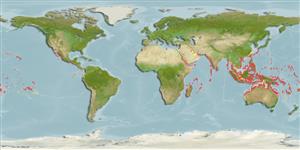Common names from other countries
Environment: milieu / climate zone / depth range / distribution range
Sinh thái học
; Mức độ sâu 0 - 30 m (Ref. 800). Tropical; 30°N - 32°S, 32°E - 78°W (Ref. 97480)
Indo-Pacific.
Length at first maturity / Bộ gần gũi / Khối lượng (Trọng lượng) / Age
Maturity: Lm 15.5 range ? - ? cm Max length : 60.0 cm TL con đực/không giới tính; (Ref. 118); common length : 20.0 cm TL con đực/không giới tính; (Ref. 122); Khối lượng cực đại được công bố: 1.0 kg (Ref. 122)
Body Width: 10 cm. Body Thickness: 0.8 cm. Mean live weight about 200 g to 1000 g; body thickness about 4 mm. Body: cylindrical, elongate, with rounded ends. Tegument smooth, often covered by sand, but also showing round patches lacking sand. A red toxic fluid is secreted upon rubbing the body surface vigorously. Podia on bivium sparsely distributed, ending in a small disc around 150 micrometer in diameter; podia on trivium numerous, short and stout, distributed on the radii and the interradii, their calcareous disc around 0.05 cm in diameter. Mouth: ventral, surrounded by 20 black tentacles. Anus terminal. Calcareous ring with large radial pieces and narrow interradials. Cuvierian tubules absent. Color: entirely black. Spicules: tegument with tables and rosettes; tables with circular disc showing 8 holes (4 central and 4 smaller holes in between) and s spire of 4 pillars, ending in maltese crown; rosettes small and simple, more abundant in ventral tegument; ventral podia without rods, but with pseudo-plates; dorsal podia and papillae with short rods, showing denticulate borders.
The mean population density is around 0.5 per square meter, but can exceed 4 per square meter. Traditionally harvested, but the processed product is of low commercial value. In recent times, due to increasing demand, this species also appears in the processed products of many Pacific Islands. Collected by hand at low tide while wading on the reefs, or by divers (Ref. 122). Processed to trepang in Puerto Princesa, Palawan (Ref. 543). A common shallow-water species, rarely found at depths of more than 20 m, mostly on inner and outer reef flats and back reefs or shallow coastal lagoons; abundant on sandy-muddy grounds with rubble or coral patches and in seagrass beds (Ref. 122). Intertidal. Also found on coarse and fine sandy areas in coral communities (Ref. 129602). Body is often almost completely covered by sand grains (Ref. 102838). The mean population density is about 0.5/square meter, but can exceed 4/square meter. Inshore shallow-water populations are denser, composed of smaller individuals, while deeper or outer reef populations, individuals are more scattered and with larger sizes (Ref. 122). Feeds on Halimeda sp. (Ref. 118). Known to release a wine-colored exudate when rubbed vigorously (Ref. 85218).
Inshore shallow-water populations composed of smaller individuals, and reproduce mostly by transversal fission, while in deeper or outer reef populations the individuals are larger, and reproduce sexually (Ref. 122).
Conand, C. 1998. (Ref. 122)
IUCN Red List Status (Ref. 130435)
CITES status (Ref. 108899)
Not Evaluated
Not Evaluated
Human uses
Các nghề cá: buôn bán nhỏ
| FishSource | Biển chung quanh ta
Các công cụ
Các nguồn internet
Estimates based on models
Preferred temperature
(Ref.
115969): 24.9 - 29.3, mean 28.4 (based on 3685 cells).
Thích nghi nhanh
Chiêù cao, thời gian nhân đôi của chủng quần tối thiểu là dưới 15 tháng (K=0.11-0.75).
Vulnerability
Moderate vulnerability (44 of 100).
Price category
Unknown.
